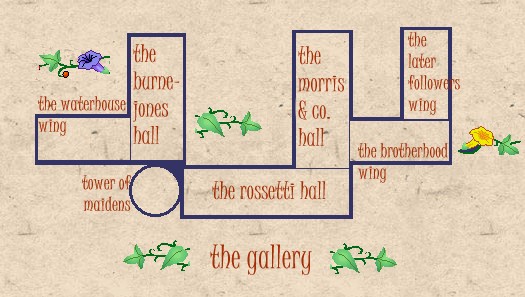The Pre-Raphaelite Brotherhood was founded in the autumn of 1848. As
William Michael Rossetti wrote in 1901, its aim was no more specific
than that 'an artist, whether painter or writer, ought to be bent upon
defining and expressing his own personal thoughts, and that they ought to
be based upon a direct study of Nature, and harmonised with her
manifestations.'
Of the seven founding members, only three are of serious
note as painters: William Holman Hunt (1827-1910), Dante Gabriel Rossetti
(1828-82) and John Everett Millais (1829-96).
The other founding members were James Collinson (1825-81) whose High Church sympathies eventually led him to embrace Catholicism and to resign from the brotherhood, Thomas Woolner (1825-92), the only sculptor of the group: Frederick George Stephens (1828-1907) a painter of the slimmest talent who soon gave up to become a teacher; and William Michael Rossetti (1829-1910) the prosaic, practical brother of Dante Gabriel and Christina Rossetti, who, despite his lack of creative ability, brought considerable critical and scholarly gifts to the movement, acting as its assiduous secretary and historian.
The movement prided itself on 'absolute and uncompromising truth in all it does, obtained in working everything, down to the most minute detail, from nature, and from nature only.' But the movement was more than simply another 'Return to Nature' group. The origins of Pre-Raphaelitism belong within that deep-seated longing for a sense of wholeness to life which had been searching for expression ever since the 1830s.
The Pre-Raphaelites strove after a unity of feeling in which the aesthetic sensibilities are riveted to the moral and imaginative bases of life. They hoped that by imbibing the simple piety they saw in early Italian painting (ie before Raphael) and welding it to the uncluttered forms of those paintings, they would similarly produce such wholehearted works.
But down this path lay a serious pitfall, one that led to the two directions Pre-Raphaelitism took: the one, a hard detailing of natural data; the other, a soft shaping of historical and archaic materials to form a romantic impression.
In reality, these two seemingly irreconcilable faces are opposite sides of the same coin. 'A technique always implies a metaphysic' wrote Sartre, and the metaphysic of medieval life was fundamentally sacramental. Every aspect of life was seen to have a dual meaning, a spiritual and earthly significance.
But the Pre-Raphaelites lived in the Victorian era, and it was inevitable that the forms of the medieval world became a clothes-horse for the artist on which he could hang a few colourful garments and arcane beliefs.
Burne-Jones, and those like him who were heavily influenced by the superficialities of Rossetti's style - Evelyn de Morgan, Frederick Sandys, Frank Dicksee, John William Waterhouse - became partners in elegant lassitude. The somnolent dreamers that they produced and perpetuated have become generally identified with a 'Pre-Raphaelite type'.
What this shoot of the movement fed on was the insubstantial hope of the late Victorian period that somwhere, beneath the blanket of materialism that was threatening to stifle every human value, lay a better world.
Summarized from 'The Pre-Raphaelites', by Andrea Rose, Phaidon, Oxford, 1977

|

